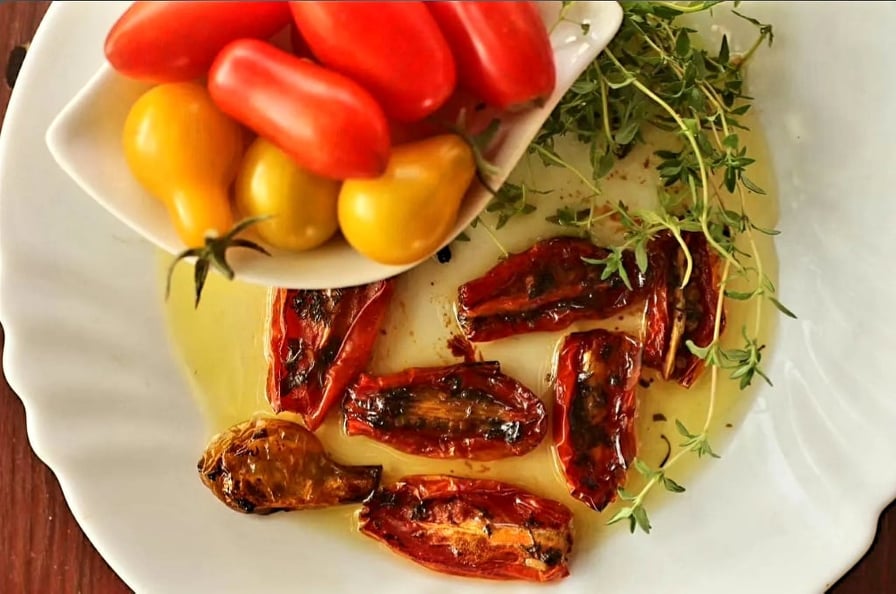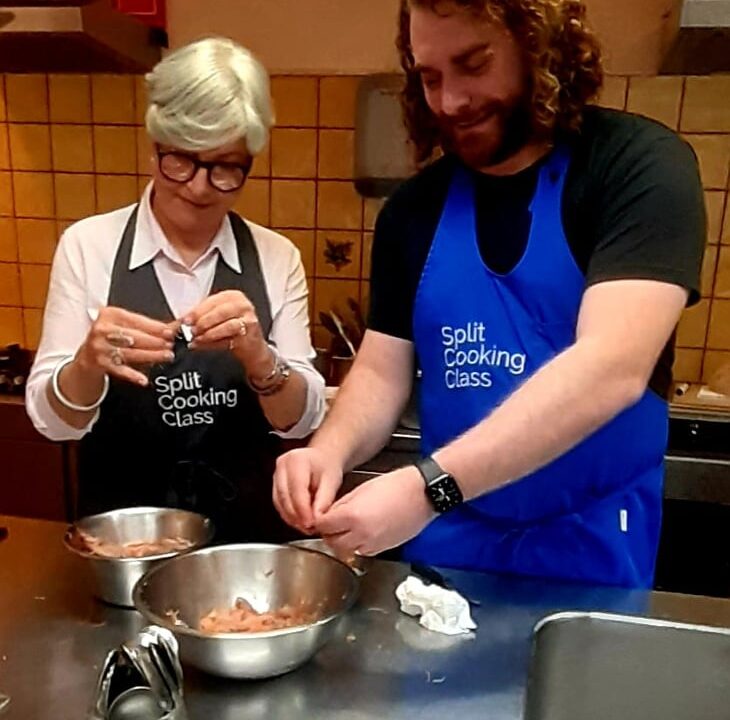
Christmas Advent Traditions in Split
January 3, 2015
Legend of the Croatian Coat of Arms
January 29, 2017
Croatian Cuisine is very diverse, reflecting the various cultures and empires that have influenced the country in the past centuries.
Along the coastline, the cuisine sharply resembles Italian?style cuisine and flavours, while in the Continental inland regions, you’ll find Austro?Hungarian and even Turkish cuisine further towards the Bosnian border. Each region has its particular specialty, and I can guarantee you’ll be surprised by the high-quality food made and prepared from fresh and seasonal products wherever you go. In all my years spent travelling around Croatia, I have found it hard to experience a bad meal!
Around the Capital, Zagreb, and in north-western Croatia, hearty meat dishes are favoured. Spit-roasted Lamb, while pork and duck are also firm favourites, and often accompanied by ?mlinci? (baked noodles) or roast potatoes. Turkey with mlinci is probably the most traditional dish in the Zagreb area, and Steak a la Zagreb is very popular..(veal stuffed with ham and cheese) and coated with breadcrumbs and fried to a golden brown.. the Hungarian influence in this region adds some wonderful goulash dishes, rich and flavoursome, and not forgetting the thin pancakes (pala?inke) filled with locally made plum jam or chocolate..some prefer lemon juice sprinkled with sugar. The wine-growing areas around Zagreb Region include Zelina Hills, Ple?ivica Hills, and Vukomeri?ke Gorice. There may be quantity in this region but certainly not the quality of other wine regions in Croatia, however, there are some first-class really excellent sparkling wines being produced by some of the dedicated wine producers such as Tomac, ?jenpjen, also chardonnay of Korak vineyard is very pleasant on the palate.
In eastern Slavonia near the Hungarian border, the cuisine becomes spicier than in other regions..garlic and paprika are used very liberally. The river Drava, provides fresh fish, mostly carp and pike. A dish called Fish Paprika? is one of the specialties of this region..the fish is simmered slowly in a paprika sauce and served with noodles. The region’s hand-made sausages are also a specialty, particularly Kulen, a paprika-flavoured sausage served with fresh cottage cheese, peppers, tomatoes, and pickled vegetables. Delicious desserts stuffed with walnuts, poppy seeds, and homemade plum jam are always popular. Together with Dalmatia and Istria, Slavonia is one of the most important wine regions. Back in the 19th Century, The wines from this region were widely drunk in the Courts of Europe, particularly the Austrian Court Hapsburg. The epicenter of Slavonian wine growing is around Kutjevo. The vineyards of Krauthaker, Enjingi, Gali?, Kutjeva?ki Podrumi, and Ilo?ki Podrumi all excel at producing some of the finest white wines in the world and many vintages including, Chardonnay, Gra?evina, Riesling Traminac, Pinot Gris and Sauvignon have been highly awarded internationally.
Coastal cuisine from Istria to southern Dalmatia is typically the Mediterranean, using lots of olive oil, garlic, fish, wine and herbs, and anything from the sea! The typical Dalmatian cuisine has not changed for centuries and the best Dalmatian cuisine remains simple, without too much fuss.
Top seafood favourites are fish, crabs, lobsters, mussels, octopi, cuttlefish, sardines, oysters, and everything else from the Adriatic sea. There are many ways to prepare them but grilling remains the most popular. (It is imperative to have particular woods to create the coals..lending particular flavours to the fish.) with gregarda, brodetto or na buzera which involves several ingredients in the same pot (usually olive oil, white wine, parsley, fresh tomatoes, onions, and garlic) as the other most popular ways of preparing seafood.
There are a few cooking rules in this region, yet one of the most popular and most healthy ways of cooking is ?na le?o?(Boiled foods) Cooked or lightly simmered John Dory is preferred by many Dalmatian chefs rather than grilled, and the same with lamb.
Pag Cheeses and dry-cured ham. Pag sheep cheese is the most best-known Croatian Cheese and is often served with dry-cured ham as a starter. The Gligora Sheep’s cheese from Island Pag has won many international gold medals over the past few years.
Pašticada is a beef dish, stuffed with ham, garlic, and cloves then marinated in red wine and vinegar. The beef and juices are slowly simmered with the juices and vegetables..resulting in a very rich sauce and served with hand-made gnocchi.
Peka ..elementary and tasty. Dalmatian lamb is often prepared on the spit in the Dalmatian hinterland. It can also be prepared under the lid of the peka pan. A cast-iron dome is placed over coals to slow-roast lamb or veal, with potatoes and some vegetables. Octopus and certain fish are also prepared this way.
Pogača Bread from Island Vis and Soparnik from the Omiš Cetina River Hinterland are becoming widely known as firm favourites with many visitors to Dalmatia. Try Pogača Bread from Island Vis with a fish filling..either as a main course or a quick bite.
Soparnik is sometimes called the Croatian pizza. This famous dish resembles a huge pizza in some aspects. The dough is spread out on the table and then filled with Swiss Chard ( similar to English spinach) onion, garlic, and olive oil, covered with another thin layer of dough, rubbed with olive oil, sprinkled with salt, and then baked on and under hot coals, so delicious!
Fritule or Rozata? Fritule are small-sized doughnuts and have a distinct flavour thanks to sultanas, a dash of Grappa or lemon rind, added to the dough. Rozata is a sweet cooked cream similar to a cr?me caramel served with caramelized sugar. A specialty of the Dubrovnik region, with the unique flavour of added, rose liqueur known as rozolin..hence the name rozata.
Dalmatian ?Fast Food? Sardines on the grill or fried, swiss chard drizzled with olive oil and finely chopped garlic pepper and salt..this is Dalmatian fast food! Fast and super healthy!

















The wines of Central and Southern Dalmatia, particularly those produced on the islands of Hvar, Brač, Korčula Vis, and the Pelja?ac Peninsula is the most important wine-growing area of Croatia. It is here in these poor stone-based soils, but under ideal climatic conditions the little blue, ‘Plavac Mali’ variety is grown. This is the most precious of Croatia’s indigenous varieties, and the variety producing the most prestigious of Croatian Red wines. There are so many vineyards that are producing outstanding wines of quality, far too many to mention here, but some of my favourites are, Andro Tomi? on Hvar, Dingac, Matu?ko Dingac and Postup of Pelja?ac, Plenkovi?, Grgi?, Ivan Dolac, Jo Ahearne and Dubokovi? on Hvar, Stina on Brač, all superb world-class wines.
In Northern Dalmatia between Zadar and Šibenik hinterland regions, the Babi? varietal is unarguably the greatest wine attraction of this area. The vineyards of Alen Bibi?, Ante Sladi?, Marko Sladi? and Testament, are all producing stunning vintages from the Babi? vines.
Michelin announce stars for Croatian restaurants
January 2024. The ten Croatian restaurants which currently hold a prestigious Michelin Star are…
Agli Amici in Rovinj. Alfred Keller in Mali Lošinj Boškinac in Novalja on the island of Pag, Draga di Lovrana in Lovran, LD Terrace in Korčula, Monte in Rovinj, Nebo in Rijeka Noel in Zagreb, Pelegrini in Šibenik and 360 Degrees in Dubrovnik.
SOME OF MY OTHER FAVOURITES IN CROATIA ARE: (in no particular order)
Konoba Campanelo in Mirlović near Šibenik
Konoba Bajso in Jesenice /Dugi Rat
Zoi in Split
Cvit Soli in Makarska
Mazzgoon in Split
Cap Aureo, Rovinj
Vele Jože – Rovinj
Artičok in Split
ManO, Zagreb
ManO2, Zagreb
Kinoteka in Split
Dalmatino in Dubrovnik
La Puntulina in Rovinj
Kasar in Zaton near Dubrovnik
Marina, Novigrad
Storia in Split
The Atrium, Zagreb
Zinfandel’s, Zagreb
Dvor in Split
Kod Marka – Šipan Harbour
Kinoteka – Split
Brasserie on 7 – Split
Zinfandel in Split
Dalmatino – Dubrovnik
Gverovi? Orsan – Zaton near Dubrovnik
Carevi Dvori – Upper Podstrana
Ciri Biri Bela – Split
Konoba Maha – Korčula
Konoba Trs – Trogir
Restoran Je? – Makarska
Restoran Lučice – Pušišće, Island Brač
Konoba Kopačina in Donji Humac Island Brač
Villa Spiza in Split – last on the list but certainly not least..an absolute favourite!!





